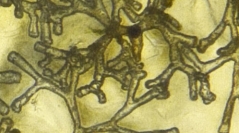Dendritic and/or rosetted microborings in calcareous and osteic skeletal substrates have a diverse trace fossil record, spanning most of the Phanerozoic, whereas the ichnodiversity of comparable bioerosion traces produced in modern seas is rather limited. The most prominent occurrences are known from Devonian brachiopods and from Upper Cretaceous belemnite rostra. Ichnotaxonomically, they are comprised within one of the few ichnofamilies established to date, the Dendrinidae Bromley et al.,
2007. As an outcome of the present revision of this ichnofamily, the plethora of 84 ichnospecies established within 25 ichnogenera since the erection of the type ichnogenus Dendrina Quenstedt, 1849 was considerably condensed to 22 ichnospecies included in 7 ichnogenera, based on a coherent morphological categorisation and ichnotaxobasis assessment. The suite of ichnogenera now subsumed within the Dendrinidae includes Dendrina Quenstedt, 1849; Clionolithes Clarke, 1908; Calcideletrix Mägdefrau, 1937; Dictyoporus Mägdefrau, 1937; Abeliella Mägdefrau, 1937; Nododendrina Vogel et al.,
1987; and Pyrodendrina Tapanila, 2008. New combinations thereby concern Dendrina dendrina (Morris, 1851) comb. nov., Clionolithes pannosus (Solle, 1938) comb. nov., C. alcicornis (Vogel et al.,
1987) comb. nov., C. convexus (Hofmann, 1996) comb. nov., Calcideletrix anomala (Mägdefrau, 1937) comb. nov., C. fastigata (Radtke, 1991) comb. nov., Dictyoporus balani (Tavernier et al., 1992) comb. nov., Nododendrina europaea (Fischer, 1875) comb. nov., N. incomposita (Mägdefrau, 1937) comb. nov. and N. paleodendrica (Elias, 1957) comb. nov. Investigation of new material and a reassessment of 63 dendrinid microborings previously addressed in informal nomenclature allowed the establishment of two complementing ichnogenera, Rhopalondendrina igen. nov. and Antodendrina igen. nov., and eight new ichnospecies, comprising Pyrodendrina arctica isp. nov., P. belua isp. nov., P. villosa isp. nov., Rhopalondendrina avis igen. et isp. nov., R. acanthina igen. et isp. nov., R. contra igen. et isp. nov., R. tigris igen. et isp. nov. and Antodendrina ligula igen. et isp. nov. In densely bioeroded calcareous substrates, different dendrinids and other bioerosion traces may be found in direct contact with each other, forming composite trace fossils, but some of these associations appear rather systematic in nature and could be the work of the same tracemaker under different behavioural modes, thus forming compound trace fossils. In these cases, however, the distinction between the two concepts remains largely equivocal. Dendrinid microborings are primarily found in living and dead calcareous skeletal substrates of bivalves, brachiopods, belemnites and corals, with complementing records from six other substrate types. Facing considerable sampling artefacts, evidence for true substrate specificity or symbiotic relationships is inconclusive as yet, whereas there is direct evidence for post-mortem infestation in several cases, such as the diverse dendrinid associations in Upper Cretaceous belemnite guards. Despite a wealth of available interpretations, the actual biological identity of the dendrinids’ tracemakers remains largely speculative. The most convincing evidence has been put forward in support of foraminiferans as the producers of Nododendrina, and excavating micro-sponges producing Clionolithes and some Calcideletrix. Since most of the dendrinids are found in aphotic (palaeo-)environments, these two principal types of organotrophic tracemakers are also potential candidates for the other ichnogenera. With regards to evolutionary patterns through geologic time, strong adaptive radiations are evident from the ichnodiversity of dendrinid ichnospecies in the Early to Mid-Palaeozoic, reflecting the “Ordovician Bioerosion Revolution” (sensu Wilson & Palmer 2006) and the “Mid-Palaeozoic Precursor of the Mesozoic Marine Revolution” (sensu Signor & Brett 1984), respectively, and in the Mesozoic, coinciding with the prominent “Marine Mesozoic Revolution” (sensu Vermeij 1977). This pattern mimics that of other micro- and macro-bioerosion trace fossils and is interpreted as a reflection of increased predation pressure and consequent infaunalisation. For extinction events, in turn, a differential effect is recorded in that the first four of the “Big Five” mass extinctions appear not to have had any noticeable effect on dendrinid ichnodiversity, whereas the end-Cretaceous mass-extinction resulted in a 77% drop following the Cretaceous peak ichnodiversity of 13 dendrinid ichnospecies.


 European Journal of Taxonomy
2017 (390) - Pages 1-99 (EJT-390)
European Journal of Taxonomy
2017 (390) - Pages 1-99 (EJT-390)